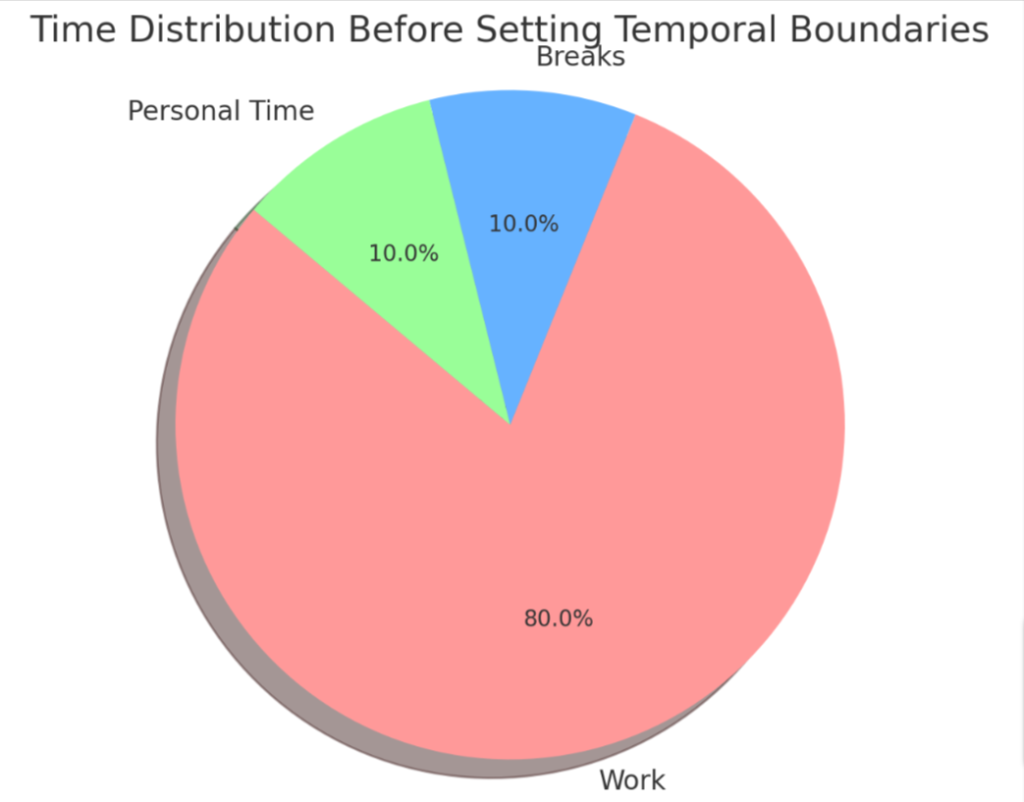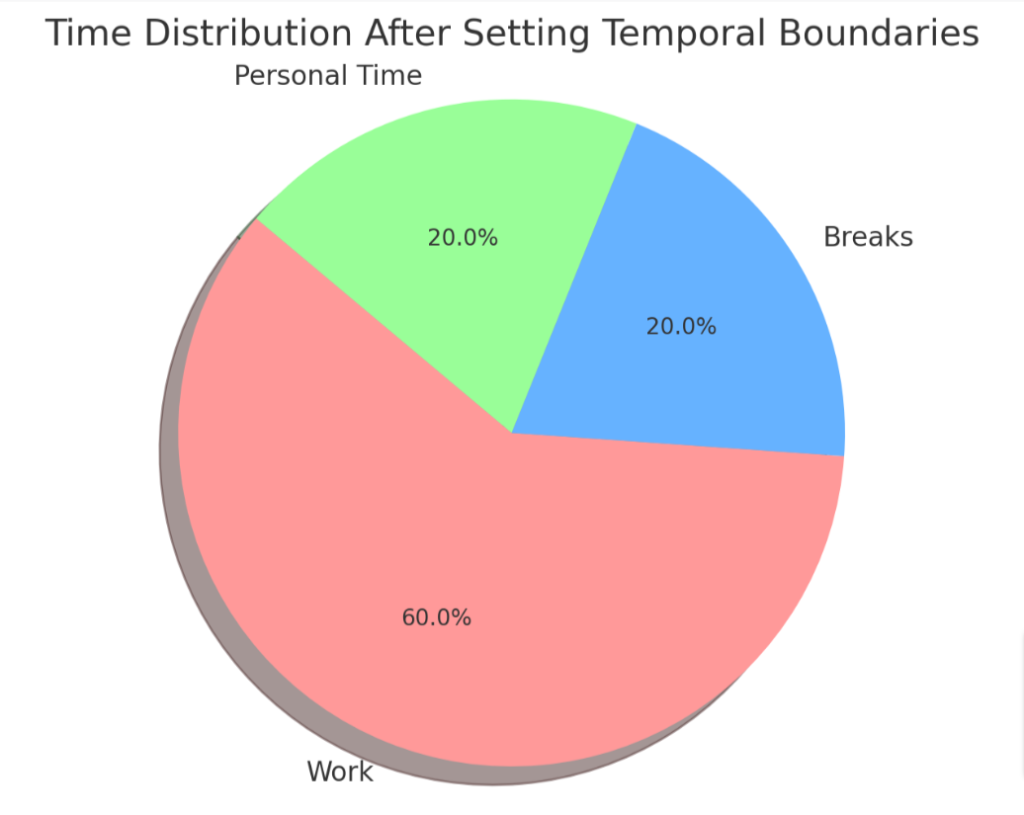Drawing the Line: Strategies for a Balanced Home Office Life
Are you feeling overwhelmed juggling your work and personal life? You’re not alone. In fact, a study from Harvard Business School found that 94% of professionals reported working over 50 hours per week.
This blog post will guide you in setting effective boundaries to achieve a healthier work-life balance. Ready to reclaim control? Let’s dive in!
Key Takeaways
- Setting boundaries between work and home life is crucial for maintaining a healthy work – life balance.
- Work boundaries include physical, temporal, emotional, psychological, and digital boundaries.
- Maintaining work-life balance benefits both employees and employers by reducing stress, improving productivity, and promoting overall well-being.
- Tips for setting boundaries at work include identifying priorities, communicating effectively, taking time off, and setting limits and schedules.
- When working remotely, it’s important to define work hours, create a dedicated workspace, establish boundaries with others, and plan for personal time.
- Regularly reviewing and adjusting boundaries is essential for achieving work – life balance.
What are Work Boundaries and Why are They Important?
Work boundaries are guidelines and limits that individuals set to separate their work life from their personal life. They are important because they help maintain a healthy work-life balance, reduce stress, and increase overall efficiency and productivity.
Types of Work Boundaries
Understanding the different kinds of work boundaries can be a game-changer for maintaining a healthy work-life balance. Here are some common types that you should know about:
- Physical Boundaries: These refer to your dedicated work zones and personal spaces.
- Temporal Boundaries: They involve defining specific working hours and break times.
- Emotional Boundaries: These lines keep professional relationships from affecting your personal well-being or emotions.
- Psychological Boundaries: These protect your thoughts, ideas, and autonomy in the workplace.
- Digital Boundaries: They include setting limits on responding to emails and other forms of online communication after work hours.
Benefits for Employees and Employers
Maintaining proper work boundaries is beneficial for both employees and employers. Here’s a closer look at the benefits detailed in a table below.
| Benefits for Employees | Benefits for Employers |
|---|---|
| Promotes work-life balance, reducing stress and burnout. | Reduces employee turnover rate, resulting in lower hiring and training costs. |
| Improves productivity and morale as employees feel more empowered. | Enhances overall productivity as happier employees are more motivated and efficient. |
| Encourages mental and physical health, improving overall well-being. | Fosters a healthier work environment, improving company culture and reputation. |
| Allows for personal growth and development outside of work. | Attracts better talent, promoting company growth and development. |
Importance of Maintaining a Work-Life Balance
Maintaining a work-life balance ranks high for overall well-being and productivity. A balanced life ensures efficiency at work while also allotting sufficient personal time, contributing to stress reduction.
Personal boundaries play a significant role in this aspect, as they provide an essential buffer between work responsibilities and home life.
Emphasizing on achieving work-life balance helps prevent burnout and enhances mental health. It encourages prioritization of tasks, which results in better time management skills. This focus leads to healthier relationships both at the workplace and at home, bringing about reduced stress levels and increased contentment.
Along with improved morale comes heightened productivity – thus highlighting how significant it is to uphold and sustain an optimal work-life balance.


Tips for Setting Boundaries at Work
Identify your priorities, communicate effectively, take time off, and set limits and schedules to establish clear boundaries at work.
Identify Priorities
Identifying priorities is essential for setting boundaries and achieving a healthy work-life balance. By determining what tasks or activities are most important to you, you can allocate your time and energy effectively.
Start by evaluating your work responsibilities and personal commitments, then prioritize them based on urgency, importance, and alignment with your overall goals. This will help you focus on the tasks that truly matter and avoid getting overwhelmed with less significant ones.
Identifying priorities allows you to make informed decisions about how to allocate your time and resources, ultimately leading to increased productivity, reduced stress levels, and greater satisfaction in both your work and personal life.
Communicate Effectively
Effective communication is a crucial skill for setting boundaries at work. By clearly and assertively expressing your needs, limits, and expectations to your colleagues or superiors, you can establish healthy boundaries that promote work-life balance.
Use direct and concise language when communicating your availability, preferred methods of communication, and acceptable working hours. This will help prevent any misunderstandings or encroachments on your personal time.
Additionally, effective communication allows you to address any concerns or conflicts that may arise regarding boundaries in a respectful manner, fostering a positive work environment for all parties involved.
In order to communicate effectively, it’s important to actively listen to others as well. Take the time to understand their perspectives and concerns about boundary-setting while respectfully standing firm on your own needs.
Take Time Off
Taking time off from work is crucial for maintaining a healthy work-life balance. It allows you to recharge and rejuvenate, ultimately increasing your productivity when you return.
By taking regular breaks, whether it’s a vacation or a simple day off, you are giving yourself the opportunity to focus on personal activities and spend quality time with loved ones.
This not only helps reduce stress but also prevents burnout, ensuring that you can sustain your performance in the long term. Remember, prioritizing self-care and allowing yourself time away from work is just as important as fulfilling your professional responsibilities.
Set Limits and Schedules
Setting limits and schedules is crucial for maintaining a healthy work-life balance. By establishing clear boundaries, you can effectively manage your time and reduce stress. Here are some tips to help you set limits and schedules:
- Prioritize your tasks: Identify the most important activities that need your immediate attention. Focus on completing these tasks first before moving on to less urgent ones.
- Delegate when possible: If there are tasks that can be delegated to others, don’t hesitate to ask for help. Delegating responsibilities can free up time for you to focus on your priorities.
- Establish a daily schedule: Create a daily routine that includes dedicated time for work, personal activities, and relaxation. Stick to this schedule as much as possible to maintain structure in your day.
- Avoid overcommitting: Learn to say no when you already have a full plate. Taking on too many responsibilities can lead to overwhelm and burnout.
- Set realistic deadlines: When setting deadlines for yourself or others, make sure they are achievable within the given timeframe. Unrealistic deadlines only add unnecessary pressure.
- Limit distractions: Minimize distractions during designated work hours by turning off notifications on your phone, closing irrelevant tabs on your computer, and creating a focused workspace.
Tips for Separating Work and Personal Life while Working Remotely
Define your work hours and stick to them consistently, creating a clear distinction between when you are “at work” and when you are not.
Define Work Hours
Defining work hours is essential for maintaining a healthy work-life balance. By clearly outlining the specific times during which you will be working, you can establish boundaries that protect your personal time and prevent burnout.
Setting definitive work hours also allows for better time management, enabling you to prioritize tasks and increase efficiency. Whether you are working remotely or in an office, defining your work hours helps create structure and promotes productivity by ensuring that you have dedicated time for both work and personal life activities.
Create a Dedicated Workspace
Creating a dedicated workspace is essential for separating work and personal life, especially when working remotely. Find a designated area in your home where you can set up your office supplies, computer, and other work-related materials.
This physical separation helps to establish clear boundaries between your professional and personal life. Having a dedicated workspace also improves focus and productivity by reducing distractions from household chores or family members.
It sends a signal to yourself and others that when you are in this space, you are in work mode. So find that separate nook or room where you can create a productive environment conducive to getting things done efficiently without unnecessary interruptions or distractions.
Establish Boundaries with Others
To maintain a healthy work-life balance, it is important to establish boundaries with others. Here are some ways you can do this:
- Clearly communicate your availability and working hours to colleagues, clients, and family members.
- Set clear expectations for response times to emails and messages.
- Avoid taking on additional tasks or responsibilities outside of your designated roles or responsibilities.
- Say “no” assertively when you feel overwhelmed or when a request doesn’t align with your priorities.
- Delegate tasks when appropriate and seek support from colleagues or family members when needed.
Plan for Personal Time
To maintain a healthy work-life balance, it is crucial to plan for personal time. This means deliberately setting aside dedicated moments for yourself outside of work commitments. By proactively scheduling personal activities and leisure time, you can ensure that you have the opportunity to recharge and relax.
Whether it’s spending quality time with loved ones, pursuing hobbies and interests, or simply taking a break to unwind, planning for personal time helps prevent burnout and promotes overall well-being.
It allows you to prioritize self-care while also maintaining the boundaries between your work and personal life.
The Importance of Regularly Reviewing and Adjusting Boundaries
Regularly reviewing and adjusting boundaries is crucial for achieving work-life balance, maintaining mental health, and improving overall productivity. Don’t miss out on the benefits of setting and protecting your boundaries – read more now!
Ensuring Work-Life Balance
To ensure a healthy work-life balance, it is crucial to establish and maintain clear boundaries between your professional and personal life. By setting limits on when and how much you work, you can prioritize your time effectively and reduce stress.
Communicating your needs to colleagues and loved ones, taking regular breaks, and carving out dedicated personal time are essential steps in achieving this balance. Regularly reviewing and adjusting your boundaries will help you stay focused on what truly matters to you, maintain good mental health, and ultimately improve productivity in all areas of your life.
Maintaining Mental Health
Maintaining mental health is crucial when it comes to setting boundaries between work and home life. Not only can blurred lines between the two cause stress and burnout, but they can also negatively impact our overall well-being.
By establishing clear boundaries, such as defining work hours and creating a dedicated workspace, we can protect our mental health by ensuring time for rest, relaxation, and personal activities.
Taking breaks throughout the day and engaging in self-care practices are also important for maintaining a healthy mindset. Prioritizing our mental health allows us to be more productive, focused, and present in both our professional and personal lives.
Improving Overall Productivity
Setting clear boundaries between work and personal life can significantly improve overall productivity. By clearly defining when you are working and when you are not, you can create a sense of structure and focus in your day.
This allows you to allocate specific time for important tasks, avoiding distractions and interruptions from your personal life. When you have a dedicated work space and establish emotional boundaries with others, it becomes easier to stay on task and maintain the necessary concentration needed for high productivity.
In addition, regularly reviewing and adjusting your boundaries ensures that you are consistently optimizing your work-life balance, maintaining your mental health, and ultimately maximizing your efficiency in both areas of your life without feeling overwhelmed or burnt out.
Conclusion
In conclusion, setting boundaries between work and home life is crucial for maintaining a healthy work-life balance. By identifying priorities, communicating effectively, and taking time off, individuals can achieve better separation between their professional and personal lives.
Establishing clear limits and schedules while working remotely also plays a vital role in reducing stress and increasing overall productivity. Regularly reviewing and adjusting these boundaries ensures ongoing success in balancing work responsibilities with personal well-being.

